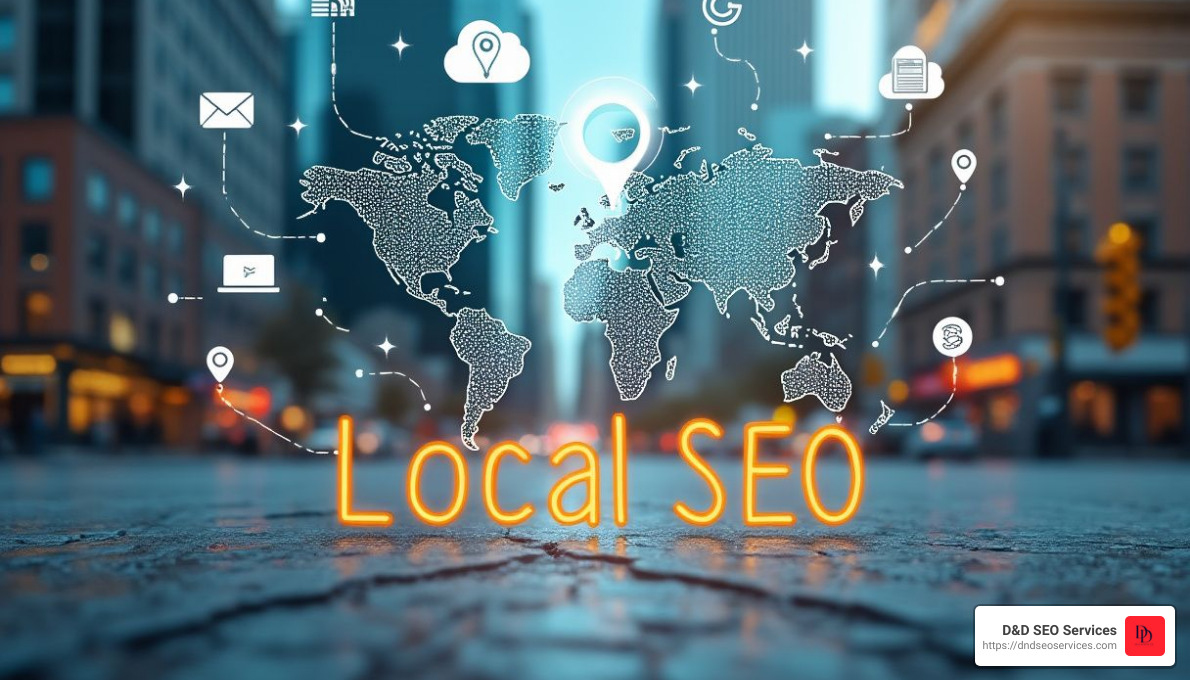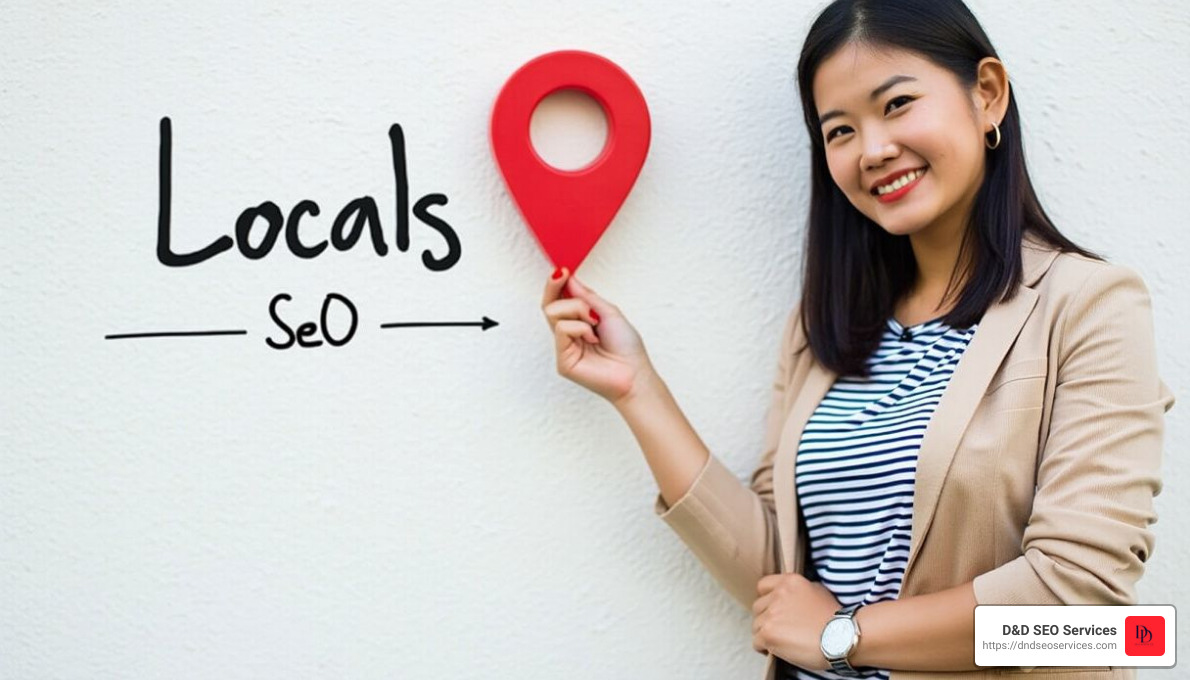97% of search engine users search online to find a local business. If users want to find a local business online, they turn to search engine users first.
Local SEO is an essential strategy for businesses looking to attract nearby customers. When people search for “coffee shops near me” or “best Italian restaurants in [city]”, it’s local SEO that determines which businesses show up prominently in the results. In this guide, we’ll break down everything you need to know to optimize your online presence for maximum local visibility.
I. What is Local SEO and Why Does It Matter?
Local SEO is a branch of search engine optimization (SEO) focused on improving a business’s visibility in geographically related searches. It’s designed to put your business on the map – literally! Think of it as your digital storefront in the neighborhood.
Here’s why local SEO matters:
- Increased Visibility: Dominating local search means people in your area find you when they need your products or services. For example, a bakery optimizing for “fresh donuts [city]” is more likely to show up when a hungry local searches for a sweet treat nearby.
- More Foot Traffic: Local SEO brings potential customers to your doorstep. People searching “near me” often have high intent to visit!
- Enhanced Reputation: A strong local search presence boosts trust and credibility. Positive reviews and consistent ranking on results pages signal to searchers that you’re a reliable option in their area.
II. Foundational Pillars of Local SEO
GMB is the cornerstone of local SEO success. Here’s how to make it work for you:
- Claim and Verify: Search for your business on Google Maps. If it exists, claim it; if not, create a listing. Verify your listing via the method Google provides to prove ownership.
- Complete Your Profile: Fill out all details accurately, including your NAP (Name, Address, Phone Number), hours, website, and category. Add high-quality photos showcasing your business and products/services. Update your hours during holidays or special events.
- Manage Reviews: Actively respond to reviews, both positive and negative. This shows engagement and builds trust. Encourage satisfied customers to leave fresh reviews regularly.
- Google Posts: Share updates, events, promotions, and limited-time offers to keep your listing fresh and inform potential customers.
2. On-Site Optimization for Local
- NAP Consistency: Ensure your business name, address, and phone number are present and identical to your GMB listing on all pages of your website (typically in your footer).
- Location-Focused Content: Include your city and region naturally in page titles, headers, and throughout your website text. For example, a landscaping company in Miami could write a blog post titled “Top 5 Tips for Miami Backyard Landscaping.”
- Location Pages: If you serve multiple areas, create dedicated pages for each location with unique content and NAP information.
- Schema Markup: Use this structured data code to help search engines better understand your local information. You can use a Schema Markup Generator (search online for free tools) for assistance.
3. Local Citations
Citations are listings of your business on directories and websites. Building quality citations with accurate information is vital.
- Target Directories: Examples include Yelp, Yellow Pages, Better Business Bureau, Apple Maps, Bing Places, and your local Chamber of Commerce. Focus on industry-specific directories too. Use a tool like Whitespark or BrightLocal to help you find relevant citation sources.
- NAP Accuracy: Meticulously ensure your NAP is consistent on every citation. Inconsistent information can hurt your search rankings.
III. Advanced Local SEO Strategies
1. Backlink Building
Backlinks (links from other websites to yours) signal authority and help boost your rankings. Here’s how to get local backlinks:
- Partnerships: Collaborate with other local businesses for cross-promotion on websites and social media. A bakery might partner with a coffee shop for a special offer.
- Sponsorships: Sponsor local events or charities and get a link from their websites.
- Guest Blogging: Write articles for local blogs or news sites with a link back to your website. Focus on topics relevant to your business and the community.
2. Voice Search Optimization
- Optimize for Questions: Target phrases like, “Where’s the best [your product/service] near me?” or “What time does [business name] close?”.
- FAQ Content: Create a page answering common local search queries to capture voice search traffic.
3. Hyperlocal Content
- Local Events and News: Write blog posts about happenings in your area and tie them back to your business (e.g., a restaurant might highlight a street festival and offer a festival-themed special).
- Local Guides: Share your expertise about the best your city or region offers and naturally integrate your services (e.g., a plumber creating a “Guide to the Best Outdoor Activities in [city] to Enjoy Leak-Free”)
4. Social Signals
- Social Media Presence: Maintain active profiles on platforms relevant to your audience (e.g., Facebook, Instagram, Twitter). Share local content, engage with followers, and include your NAP info in your bios.
IV. Tracking and Measurement
- GMB Insights: Track website clicks, calls, direction requests, and more to see how your local SEO efforts translate to actions.
- Local Keyword Ranking Tools: Use tools like Semrush or Moz Local to monitor your search visibility for location-based keywords.
- Website Analytics: See if your organic traffic from local sources is increasing. Focus on website conversions like form submissions and phone calls too.
V. Special Circumstances
- Multi-Location Businesses: Create separate location pages and GMB listings for each branch. Use a store locator tool on your website to help users find the nearest location.
- Service-Area Businesses (SABs): Optimize for broader service regions rather than a specific address. You can hide your address on your GMB listing. Clearly define the cities and neighborhoods you serve directly on your website.
VI. Ongoing Maintenance and Best Practices
Local SEO is an ongoing process. Here’s how to stay on top of it:
- Regular GMB Updates: Keep your listing fresh with new photos, posts, and updates about hours or services.
- Fresh Content Creation: Consistently publish new location-focused blog posts, guides, or resources.
- Active Reputation Management: Monitor and respond to reviews on GMB, Yelp, and other platforms where customers leave feedback.
- Periodic Local SEO Audits: Use tools to identify NAP inconsistencies across the web and fix errors. Regularly review your local rankings to spot new opportunities.
Get Started and Dominate Local Search!
By following this guide, you’ll establish a strong foundation and unlock advanced optimization strategies to boost your local presence. Remember, local SEO takes effort, but the payoff of seeing your business thrive locally is well worth it!
Don’t Let Competitors Outrank You – Schedule Your Strategy Call Now
Contact us today and let’s turn your website into a revenue-generating machine!






